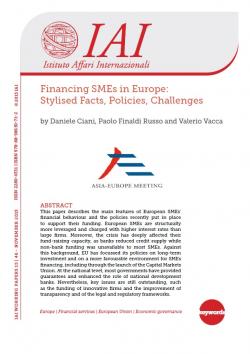Financing SMEs in Europe: Stylised Facts, Policies, Challenges
This paper describes the main features of European SMEs’ financial behaviour and the policies recently put in place to support their funding. European SMEs are structurally more leveraged and charged with higher interest rates than large firms. Moreover, the crisis has deeply affected their fund-raising capacity, as banks reduced credit supply while non-bank funding was unavailable to most SMEs. Against this background, EU has focussed its policies on long-term investment and on a more favourable environment for SMEs financing, including through the launch of the Capital Markets Union. At the national level, most governments have provided guarantees and enhanced the role of national development banks. Nevertheless, key issues are still outstanding, such as the funding of innovative firms and the improvement of transparency and of the legal and regulatory frameworks.
Background document for the ASEM seminar on “Financing SMEs in Asia and Europe”, held in Rome on 29-30 October 2015.
-
Details
Roma, IAI, November 2015, 30 p. -
Issue
15|46 -
ISBN/ISSN/DOI:
978-88-98650-71-2
Executive summary
1. SME financing: structural features and recent trends
1.1 The role of SMEs in Europe
1.2 The financial structure of European SMEs
1.3 Recent trends in SMEs financing
2. Policies for SME financing
2.1 Policies at the European level
2.2 Country-level policies
2.2.1 Public guarantees and their effectiveness
2.2.2 Assisting distressed SMEs
2.2.3 Encouraging non-bank financing
2.2.4 The visible hand: National development banks (NDBs)
2.2.5 Supporting high-growth firms
3. Outstanding issues
3.1 Funding
3.2 Regulation and information
References
Topic
Tag
Related content
-
Ricerca13/04/2016
Asia-Europe Meeting (ASEM)
leggi tutto -
Event12/10/2015
Financing SMEs in Asia and Europe
leggi tutto



